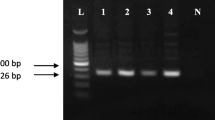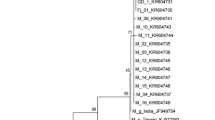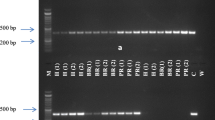Abstract
Stubby root nematodes are of increasing importance to the potato industry in the Pacific Northwest (PNW) of the USA as they transmitTobacco rattle virus (TRY), the causal agent of corky ringspot disease. In the PNW,Paratrichodorus allius is the most prevalent TRV vector nematode species in potato growing areas. A closely related species,P. teres, is also found in parts of the PNW.P. allius andP. teres are morphologically similar, thus creating problems for routine identification. Few studies have utilized molecular techniques to identify species belonging to the Trichodoridae. Species-specific reverse PCR primers for bothParatrichodorus species were designed and located in the ITS-1 rDNA region and used in combination with a universal nematode forward primer located in the 18S rDNA. Primer reliability was confirmed byin vitro screening of differentP. allius populations andin silico analysis ofP. teres on the respective target species. Furthermore, specificity was demonstrated by the absence of cross-reactions with a range of common plant-parasitic nematode species typical of potato growing areas in the PNW. A duplex PCR test was developed that was effective for simultaneous detection of both targetParatrichodorus species.
Resumen
Los nematodos que causan la raíz tocón son de creciente importancia para la industria papera en el Pacífico Noroeste (PNW) de EUA porque transmiten elTobacco rattle virus (TRV), agente causal del anillo corchoso. En el PNW, elParatrichodorus allius es el más importante vector del TRV en las áreas de cultivo de papa. También está presente en ciertas partes del PNWP. teres, una especie relacionada.P. allius yP. teres son morfológicamente similares, por lo que crean problemas para una identificación de rutina. Algunos estudios han utilizado técnicas moleculares para identificar las especies pertenecientes a los Trichodoridae. Los iniciadores de PCR en reversa, específicos para ambas especies deParatrichodorus han sido diseñados y localizados en la región ITS-1 rADN y usados en combinación de un iniciador en la región 18S rADN. La confiabilidad del iniciador fue confirmada en un tamizadoin vitro de diferentes poblaciones deP. allius y en análisisin silico deP. teres, sobre las respectivas especies objetivo. Más aún, la especificidad fue demostrada por ausencia de reacciones cruzadas con una gama de especies de nematodos parásitos de plantas típicas de las áreas de cultivo de papa en el PNW. Ha sido desarrollada una prueba de PCR doble que fue más efectiva para la detección de simultánea de ambas especies deParatrichodorus.
Similar content being viewed by others
Literature cited
Andre HM, X Ducarme, JM Anderson, JDA Crossley, HH Koehler, MG Paoletti, DE Walter and P Lebrun. 2001. Skilled eyes are needed to go on studying the richness of the soil. Nature 409:761.
Blok VC, G Malloch, B Harrower, MS Phillips and TC Vrain. 1998. Intraspecific variation in ribosomal DNA in populations of the potato cyst nematodeGlobodera pallida. J Nematol 30:262–274.
Boutsika K. 2002. Molecular identification and phylogenies of virus and non-virus vector trichodorid nematodes. Ph.D Thesis. University of Dundee, UK.
Boutsika K, DJF Brown, MS Phillips and VC Blok. 2004a Molecular characterisation of the ribosomal DNA ofParatrichodorus macrostylus, P. pachydermus, Trichodorus primitivus andT. similis (Nematoda: Trichodoridae). Nematology 6:641–654.
Boutsika K, MS Phillips, SA MacFarlane, DJF Brown, RC Holeva and VC Blok. 2004b. Molecular diagnostics of some trichodorid nematodes and associated Tobacco rattle virus. Plant Pathol 53:110–116.
Brown DJF and B Weischer. 1998. Specificity, exclusivity and complementarity in the transmission of plant viruses by plant parasitic nematodes: An annotated terminology. Fund Appl Nematol 21:1–11.
Brown EB and GB Sykes. 1973. Control ofTobacco rattle virus (spraing) in potatoes. Ann Appl Biol 75:462–464.
Coomans A. 2002. Present status and future of nematode systematics. Nematology 4:573–582.
Dale MFB, DJ Robinson, DW Griffiths, D Todd and H Bain. 2000. Effects of tuber-borne M-type strain of tobacco rattle virus on yield and quality attributes of potato tubers of the cultivar Wilja. Eur J Plant Pathol 106:275–282.
Dale MFB, DJ Robinson and D Todd. 2004. Effects of systemic infections withTobacco rattle virus on agronomic and quality traits of a range of potato cultivars. Plant Pathol 53:788–793.
Decraemer W. 1995. The family Trichodoridae: Stubby root and virus vector nematodes. Kluwer Academic Publishers. p 360.
Decraemer W and P Baujard. 1998. A polytomous key for the identification of species of the family Trichodoridae Thorne, 1935 (Nematoda: Triplonchida). Fundam Nematol 21:37–62.
Harrison BD and JI Cooper. 1974. Studies on the nature of the resistance of potato cultivars to Tobacco Rattle Virus. Potato Res 17:348–349.
Harrison BD and DJ Robinson. 1986. Tobrviruses.In: Van Regenmorrel, H Fraenkel-Conner (eds), The Plant Viruses. Plenum Press, New York. pp 339–369.
Holeva RC, MS Phillips, R Neilson, DJF Brown, V Young, K Boutsika and VC Blok. 2006. Real-time PCR detection and quantification of vector trichodorid nematodes and Tobacco rattle virus. Mol Cell Probes 20:203–211.
Hübschen J, L Kling, U Ipach, V Zinkernagel, N Bosselut, D Esmenjaud, DJF Brown and R Neilson. 2004a. Validation of the specificity and sensitivity of species-specific primers that provide a reliable molecular diagnostic forXiphinema diversicaudatum, X. index andX. vuittenezi. Eur J Plant Pathol 110:779–788.
Hübschen J, L Kling, U Ipach, V Zinkernagel, DJF Brown and R Neilson. 2004b. Development and validation of species-specific primers that provide a molecular diagnostic for virus-vector longidorid nematodes and related species in German viticulture. Eur J Plant Pathol 110:883–891.
Jensen HJ, PA Koepsell and TC Allen. 1974. Tobacco rattle virus and nematode vectors in Oregon. Pl Dis Rep 58:269–271.
Karanastasi E, W Decraemer, PE Kyriakopoulou and R Neilson. 2005. First report of the stubby-root nematodeParatrichodorus teres associated with artichoke (Cynara scolymus L.) in Greece. Plant Dis 89:685.
Karanastasi E, W Decraemer, J Zheng, MAT Almeida and DJF Brown. 2001. Interspecific differences in the fine structure of the body cuticle of Trichodoridae Thorne, 1935 (Nematoda: Diphetherophorina) and review of anchoring structures of the epidermis. Nematology 3:525–533.
Lister RM and CE Bracker. 1969. Defectiveness and dependence in three related strains of tobacco rattle virus. Ann Appl Biol 98:243–254.
MacFarlane S, R Neilson and DJF Brown. 2002. Nematodes. Adv Bot Res 36:169–198.
Mojtahedi H and GS Santo. 1999. Ecology ofParatrichodorus allius and its relationship to the corky ring-spot disease of potato in the Pacific Northwest. Amer J Potato Res 76:273–280.
Mumford RA, K Walsh, I Barker and N Boonham. 2000. Detection ofPotato mop top virus andTobacco rattle virus using a multiplex real-time fluorescent reverse-transcription polymerase chain reaction assay. Phytopathology 90:448–453.
Oliveira CMG, B Fenton, G Malloch, DJF Brown and R Neilson. 2005. Development of species-specific primers for the ectoparasitic nematode speciesXiphinema brevicolle, X. diffusum, X. elongatum, X. ifacolum andX. longicaudatum (Nematoda: Longidoridae) based on ribosomal DNA sequences. Ann Appl Biol 146:281–288.
Ploeg AT, CJ Asjes and DJF Brown. 1991. Tobacco rattle virus serotypes and associated nematode vector species of Trichodoridae in the bulb-growing areas in the Netherlands. Neth J Pl Path 97:311–319.
Ploeg AT, DJF Brown and DJ Robinson. 1992. The association between species ofTrichodorus andParatrichodorus vector nematodes and serotypes of tobacco rattle tobravirus. Ann Appl Biol 121:619–630.
Ploeg AT and W Decraemer. 1996. The occurrence and distribution of trichodorid nematodes and associated tobraviruses in Europe. Nematologica 43:228–251.
Powers TO, TC Todd, AM Burnell, PCB Murray, CC Fleming, AL Szalanski, BA Adams and TS Harris. 1997. The rDNA internal transcribed spacer region as a taxonomic marker for nematodes. J Nematol 29:441–450.
Riga E and H Collins. 2004. Green manure effects onMeloidogyne chitwoodi andParatrichodorus allius, economically important nematodes of potatoes in the Pacific Northwest of the USA. Agroindustria 3:321–322.
Riga E and R Neilson. 2005. First Report of the stubby-root nematode,Paratrichodorus teres, from potato in the Columbia Basin of Washington State. Plant Dis 89:1361.
Shields R, CC Fleming and R Stratford. 1996. Identification of potato cyst nematodes using the polymerase chain reaction. Fundam Nematol 19:167–173.
Stanton JM, CD McNicol and V Steele. 1998. Non-manual lysis of second-stageMeloidogyne juveniles for identification of pure and mixed samples based on the polymerase chain reaction. Aust Plant Path 27:112–115.
Taylor CE and DJF Brown. 1997. Nematode Vectors of Plant Viruses. CAB International, Wallingford, UK pp 286.
Taylor CE, DJF Brown, R Neilson and AT Jones. 1994. The persistence and spread ofXiphinema diversicaudatum in cultivated and uncultivated biotopes. Ann Appl Biol 124:469–477.
Thomas PE, GS Santo and CR Brown. 1993. Corky ringspot in the Columbia Basin. Spud Topics 38:24.
Thompson JD, TJ Gibson, F Plewniak, F Jeanmougin and DG Higgins. 1997. The ClustalX windows interface: Flexible strategies for multiple sequence alignment aided by quality analysis tools. Nucleic Acids Res 24:4876–4882.
Uehara T, T Mizukubo, A Kushida and Y Momota. 1998. Identification ofPratylenchus coffeae andP. loosi using specific primers for PCR amplification of ribosomal DNA. Nematologica 44:357–368.
Van Hoof HA. 1962.Trichodorus pachydermus andT. teres, vectors of the early browning virus of peas. Tijd Planten 68:391–396.
Van Hoof HA. 1964. Serial transmission of rattle virus by a single male ofTrichodorus pachydermus Seinhorst. Nematologica 10:141–144.
Waeyenberge L, A Ryss, M Moens, J Pinochet and TC Vrain. 2000. Molecular characterization of 18Pratylenchus species using rDNA restriction fragment length polymorphism. Nematology 2:139–142.
Wang X, N Bosselut, C Castagnone, R Voisin, P Abad and D Esmenjaud. 2003. Multiplex polymerase chain reaction identification of single individuals of the Longidorid nematodesXiphinema index, X. diversicaudatum, X. vuittenezi, andX. italiae using specific primers from ribosomal genes. Phytopathology 93:160–166.
Xenophontos S, DJ Robinson, MFB Dale and DJF Brown. 1998. Evidence for persistent, symptomless infection of some potato cultivars with tobacco rattle virus. Potato Res 41:255–265.
Zijlstra C, AEM Lever, BJ Uenk and CH van Silfhout. 1997. Differences between ITS regions of isolates of root-knot nematodesMeloidogyne hapla andM. chitwoodi. Phytopathology 85:1231–1237.
Zijlstra C, BJ Uenk and CH van Silfhout. 1995. A reliable, precise method to differentiate species of root-knot nematodes in mixtures on the basis of ITS-RFLPs. Fundam Nematol 20:59–63.
Author information
Authors and Affiliations
Corresponding author
Rights and permissions
About this article
Cite this article
Riga, E., Karanastasi, E., Marcelo, C. et al. Molecular identification of two stubby root nematode species. Amer J of Potato Res 84, 161–167 (2007). https://doi.org/10.1007/BF02987139
Accepted:
Issue Date:
DOI: https://doi.org/10.1007/BF02987139




